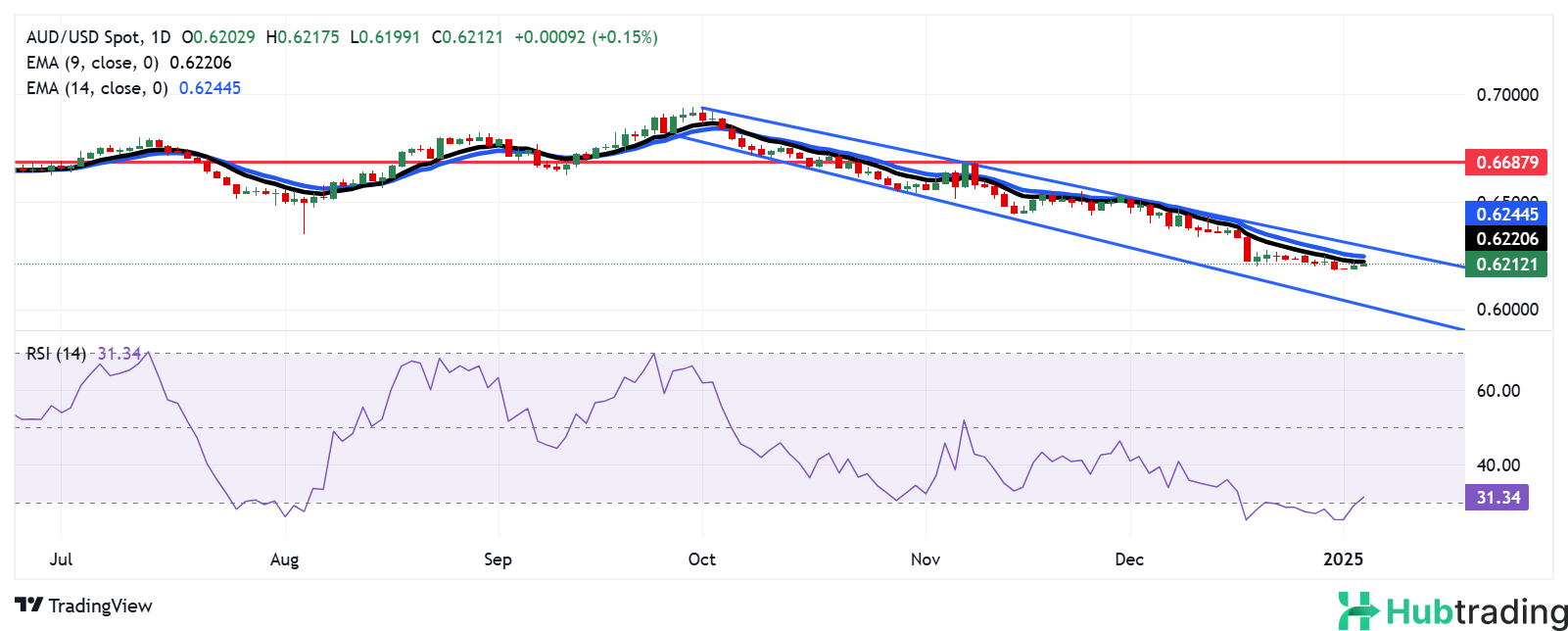- The Australian Dollar (AUD) rises as the Financial Times reports that the People’s Bank of China (PBoC) is signaling potential rate cuts this year.
- The AUD recovers from two-year lows, supported by stronger commodity prices, particularly Oil and Gold.
- The US Dollar Index (DXY) corrects downwards after reaching a new multi-year high of 109.56 on Thursday.
The Australian Dollar (AUD) extends its gains for a second consecutive session against the US Dollar (USD) on Friday, bolstered by a Financial Times report that the People’s Bank of China (PBoC) is considering an interest rate cut this year. As a key trading partner, China’s economic movements strongly influence Australia, and traders are eyeing the upcoming ISM US Manufacturing Purchasing Managers Index (PMI) for December 2024, due later in the North American session.
China’s National Development and Reform Commission (NDRC) expressed confidence in continued economic recovery in 2025, outlining plans to increase funding for ultra-long treasury bonds to support key programs and drive steady consumption growth.
The AUD/USD pair gains further as the Australian Dollar rebounds from two-year lows, supported by stronger commodity prices, particularly Oil and Gold. This rise benefits Australia as a major exporter of these resources, with Oil and Gold stocks like Woodside Energy and Northern Star Resources seeing notable gains. Additionally, the release of China’s Caixin Manufacturing Purchasing Managers’ Index (PMI) on Thursday showed continued growth in supply and demand, with manufacturers’ output expanding for the 14th consecutive month and total new orders increasing for the third straight month.
Daily Digest Market Movers: Australian Dollar Strengthens Amid Fed’s Hawkish Shift
- The US Dollar Index (DXY), which tracks the USD against six major currencies, reached a fresh multi-year high of 109.56 following the US Initial Jobless Claims data on Thursday before easing slightly to trade around 109.10 at the time of writing.
- US Initial Jobless Claims for the week ending December 27 came in lower than expected, with 211K individuals claiming jobless benefits for the first time, compared to estimates of 222K and the previous release of 220K.
- Traders are cautious about President-elect Trump’s economic policies, with concerns that tariffs could increase the cost of living. These concerns are compounded by the Federal Open Market Committee’s (FOMC) recent projections, indicating fewer rate cuts in 2025, as the Fed remains cautious amidst persistent inflationary pressures.
- Geopolitical tensions in the Middle East and the ongoing Russia-Ukraine conflict are likely to support the USD, traditionally viewed as a safe-haven currency, in the near term. Analysts at Action Economics noted, “The greenback has been boosted by rising growth concerns elsewhere amid geopolitical risks.”
- China’s Caixin Manufacturing PMI unexpectedly dropped to 50.5 in December, down from 51.5 in November, falling short of the market’s anticipated reading of 51.7.
- The Reserve Bank of Australia (RBA) board noted that if future data aligns with or falls below forecasts, it would increase confidence in inflation and make it appropriate to begin easing policy restrictions. Conversely, stronger-than-expected data could lead to maintaining restrictive policies for a longer period.
- RBA Governor Michele Bullock emphasized the continued strength of the labor market as a key reason why the RBA has been slower than other countries to initiate monetary easing.
Technical Analysis: Australian Dollar Holds Position Above 0.6200 Near Nine-Day EMA
The AUD/USD trades near 0.6210 on Thursday, maintaining a bearish outlook as it remains within a descending channel on the daily chart. However, the 14-day Relative Strength Index (RSI) has rebounded above the 30 level, suggesting potential for a near-term upward correction despite the prevailing downtrend.
The AUD/USD pair may encounter immediate resistance at the nine-day Exponential Moving Average (EMA) around 0.6220, with the next obstacle at the 14-day EMA at 0.6244. A significant resistance level is the upper boundary of the descending channel, near the psychological mark of 0.6300.
On the support side, the AUD/USD pair could find support around the lower boundary of the descending channel, near 0.6020.
AUD/USD: Daily Chart






